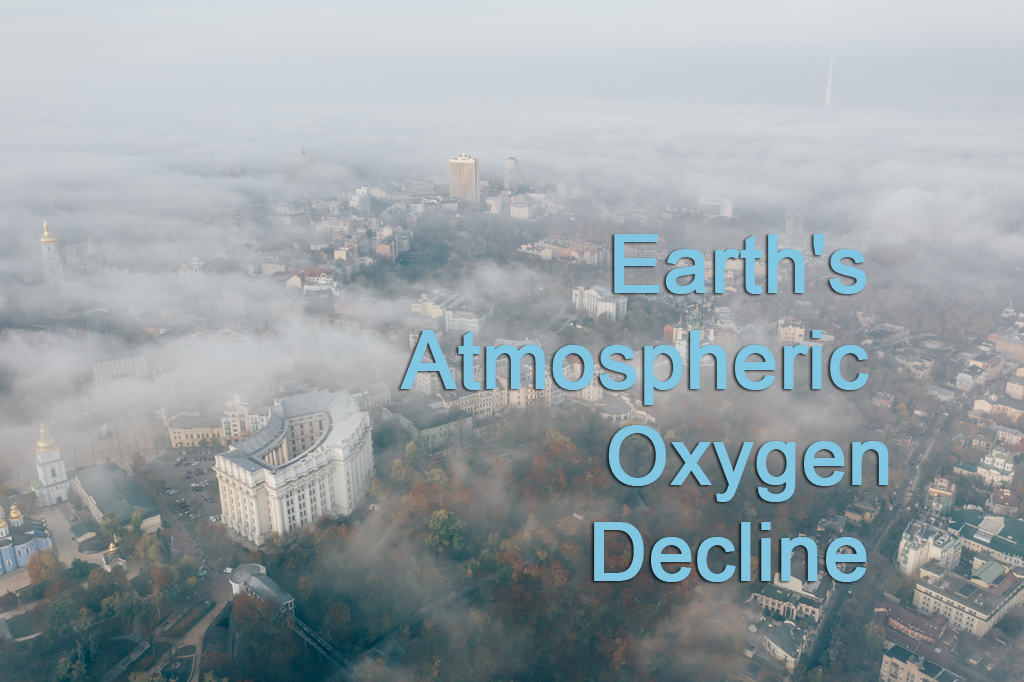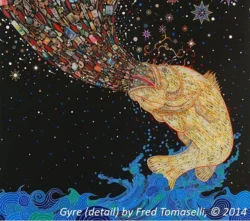Earth’s atmosphere, a critical component of the planet’s life-support system, contains approximately 21% oxygen, essential for the respiration of most living organisms. However, scientific evidence suggests that Earth’s atmospheric oxygen levels are undergoing a slow but measurable decline. A landmark study from Princeton University, analyzing ice cores from Antarctica and Greenland, indicates a 0.7% decrease in atmospheric oxygen over the past 800,000 years, with an additional 0.1% drop in the last century due to human activities such as fossil fuel combustion (Stolper et al., 2016). Concurrently, the world’s oceans are experiencing a more rapid deoxygenation, with a 2% global decrease in oxygen content since the 1950s, leading to the expansion of oxygen-depleted “dead zones” that threaten marine ecosystems (Breitburg et al., 2018; Schmidtko et al., 2017).
While the current rate of atmospheric oxygen decline is not an immediate threat to terrestrial life, it underscores the interconnectedness of Earth’s environmental systems and raises concerns about long-term habitability. Projections suggest that oxygen levels may remain sufficient for thousands of years, but in the distant future, approximately a billion years from now, the atmosphere could become inhospitable for complex aerobic organisms due to changes driven by the aging sun and reduced photosynthesis (Ozaki & Reinhard, 2021). This introduction sets the stage for a comprehensive exploration of the causes, impacts, and potential mitigation strategies for Earth’s atmospheric oxygen decline.
Historical Perspective
The history of oxygen in Earth’s atmosphere provides essential context for understanding current trends. For the first two billion years of Earth’s existence, atmospheric oxygen was nearly nonexistent, at levels as low as 0.001% of present atmospheric levels (PAL). The Great Oxidation Event (GOE), occurring approximately 2.4 billion years ago, marked a significant increase in oxygen levels due to the photosynthetic activity of cyanobacteria, enabling the evolution of complex life forms. Subsequent fluctuations, such as the Lomagundi-Jatuli Event around 2.3 billion years ago, temporarily elevated oxygen levels to near-modern values.
More recent research, including a 2021 study extending the ice core record to 1.5 million years, suggests that the decline in atmospheric oxygen began around the Mid-Pleistocene Transition (1.2 million to 700,000 years ago), when glacial cycles lengthened (Yan et al., 2021). Over the past 800,000 years, oxygen has declined by 0.7%, a pace considered reasonable by geological standards, but the last century has seen a faster decline of 0.1% due to human-induced factors (Stolper et al., 2016).
Current Status
The current rate of atmospheric oxygen decline is approximately 4 parts per million (ppm) per year, equivalent to losing one oxygen molecule for every five million air molecules, according to the Scripps Institution of Oceanography. This translates to an annual loss of less than 0.001%, suggesting that significant changes would take over 1,000 years to become noticeable. The Princeton study confirms that over the past 800,000 years, atmospheric oxygen has decreased by 0.7%, with human activities, particularly fossil fuel burning, contributing an additional 0.1% decline in the last century (Stolper et al., 2016).
| Metric | Details |
|---|---|
| Current Oxygen Level | ~21% of Earth’s atmosphere |
| Historical Decline (800,000 years) | 0.7% relative to current levels |
| Recent Decline (Past 100 Years) | 0.1% due to fossil fuel burning |
| Annual Decline Rate | ~4 ppm (0.001%) per year |
| Timeframe for Noticeable Change | Over 1,000 years |
Causes of Decline
The decline in atmospheric oxygen results from both natural and human-induced factors:
- Natural Causes: Over geological timescales, oxygen levels fluctuate due to processes like increased erosion, which exposes oxygen-consuming materials such as pyrite and organic carbon, and ocean cooling, which increases oxygen solubility in water. These processes have contributed to the long-term decline observed in ice core records.
-
Anthropogenic Causes: Human activities, particularly the combustion of fossil fuels, consume oxygen to produce carbon dioxide (CO2), with each CO2 molecule removing two oxygen atoms. Deforestation reduces oxygen production by diminishing photosynthesizing plants and algae, which account for approximately 70% of atmospheric oxygen, primarily through oceanic phytoplankton. The global population, exceeding 7.5 billion, also contributes to oxygen consumption through respiration, though this impact is minor compared to industrial activities.
Environmental Impact
The decline in atmospheric oxygen has broader environmental implications, particularly in marine ecosystems:
- Atmospheric Effects: The current rate of decline is not an immediate threat, as oxygen levels remain well above the minimum required for terrestrial life. However, it serves as an indicator of environmental stress, particularly when coupled with rising CO2 levels.
- Oceanic Deoxygenation: Oceans are experiencing a more rapid oxygen decline, with a 2% global decrease since the 1950s, driven by warming waters that hold less dissolved oxygen and increased nutrient runoff causing algal blooms (Breitburg et al., 2018; Schmidtko et al., 2017). In some tropical regions, declines reach 40–50%, leading to the expansion of Oxygen Minimum Zones (OMZs) and “dead zones,” such as those observed around Tampa Bay in 2020 and Cape Cod, where mass lobster die-offs occurred. Projections suggest a further 3–7% decline by 2100 under a business-as-usual scenario
| Oceanic Oxygen Decline | Details |
|---|---|
| Historical Decline | 2% global decrease since the 1950s |
| Projected Decline by 2100 | Up to 7% global decrease |
| Regional Impact | 40–50% decrease in some tropical regions |
| Dead Zone Examples | Tampa Bay (2020), Cape Cod lobster die-offs (2020) |
| Source | Breitburg et al., 2018; Schmidtko et al., 2017 |
Future Projections
Long-term projections of atmospheric oxygen levels suggest significant challenges. A study published in New Scientist indicates that in approximately one billion years, the aging sun will increase temperatures, reducing atmospheric CO2 and leading to the extinction of photosynthesizing organisms. This would cause oxygen levels to plummet, potentially supporting only microbial life. More immediate projections, based on a parabolic decline model, suggest that oxygen levels could reach critically low levels for human survival in about 3,600 years. While these timelines are distant, they underscore the need to address oxygen decline within the context of broader environmental changes.
| Projection Timeline | Oxygen Level Outcome | Source |
|---|---|---|
| ~1 Billion Years | Very low oxygen, microbial life only | New Scientist |
| ~3,600 Years | Critically low for human survival | PMC – Human Physiological Impact |
Human Health Implications
Significant declines in atmospheric oxygen could pose health risks similar to those experienced at high altitudes. Chronic exposure to low oxygen levels may lead to conditions like chronic mountain sickness (CMS), characterized by excessive red blood cell production, pulmonary hypertension, and right ventricular failure. Fetal development could also be affected, with risks such as reduced birth weights and increased complications like pre-eclampsia. A study estimates that in approximately 3,600 years, sea-level oxygen concentrations could resemble those at 5,100 meters, as seen in high-altitude regions like La Riconada, Peru.
However, human adaptability offers some resilience. High-altitude populations, such as Tibetans, Andeans, and Ethiopians, have developed genetic adaptations to low-oxygen environments, including increased ventilation, elevated hemoglobin concentrations, and enhanced nitric oxide levels. These adaptations suggest that humans may tolerate declining oxygen levels to some extent, though significant challenges would arise if deoxygenation accelerates.
| Phenotype | Andean | Tibetan | Ethiopian |
|---|---|---|---|
| Resting Ventilation | No increase | 50% higher | Not reported |
| Hypoxic Ventilatory Response | Blunted (low) | Similar to sea level | Not reported |
| Arterial Oxygen Saturation | Elevated | No increase | Elevated |
| Hemoglobin Concentration | Elevated | No increase (up to 4,000 m) | No increase (up to 4,000 m) |
| Pulmonary Arterial Pressure | Elevated | Minimal increase | Elevated |
| Nitric Oxide Levels | Elevated | Markedly elevated | Not reported |
| Birth Weight | Elevated | Elevated | Not reported |
| CMS Incidence | Frequent | Rare | Very rare |
| Source | PMC – Human Physiological Impact |
Ongoing Research and Mitigation Efforts
Research institutions like Princeton University and the Scripps Institution of Oceanography continue to monitor oxygen levels through ice core analysis and direct atmospheric measurements. The Princeton study, published in Science on September 23, 2016, provides a long-term perspective on oxygen decline, while ongoing monitoring tracks short-term trends. These efforts are crucial for understanding the trajectory of oxygen loss and its implications.
Mitigation strategies focus on addressing the primary causes of oxygen decline:
- Reducing Fossil Fuel Use: Transitioning to renewable energy sources, such as solar and wind, can decrease oxygen consumption through combustion.
- Protecting and Restoring Forests: Forests and oceanic algae are vital for oxygen production. Conservation and reforestation efforts can help maintain oxygen levels.
- Sustainable Practices: Adopting sustainable agricultural and industrial practices can reduce environmental stress, indirectly supporting oxygen levels.
Conclusion
The decline in Earth’s atmospheric oxygen, while currently slow, is a multifaceted issue intertwined with climate change, biodiversity loss, and human health. Ice core data from Princeton University reveal a 0.7% decline over 800,000 years, with an additional 0.1% drop in the past century due to human activities. Oceans face a more immediate crisis, with deoxygenation threatening marine ecosystems and fisheries. For humans, long-term health implications are concerning, though adaptability offers some hope.
Addressing this issue requires urgent action, including reducing fossil fuel use, protecting forests, and promoting sustainable practices. While the most severe projections span thousands to billions of years, the interconnected nature of these environmental changes emphasizes the need for proactive measures to ensure Earth’s habitability for future generations. Continued research and global cooperation are essential to mitigate the impacts of oxygen decline and preserve the delicate balance of life on our planet.





